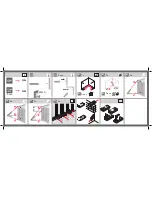
172-65639M-01 (EF200) 13 Apr 2018
9
3.3 Installation Conditions
A vortex flowmeter requires a fully developed flow profile as a prerequisite for
measuring volume accurately. The following points must therefore be noted
when mounting the EF200 in the pipeline.
Pipe Inner Diameter
When ordering, ensure that the nominal diameter and pipe schedule
(DIN/ANSI/JIS) are correct, since calibration of the flowmeter and therefore the
achievable accuracy of the measuring point are dependent on these
specifications.
3.3.1 Upstream and Downstream Sections
To ensure an undisturbed flow profile,
the vortex flowmeter should be
mounted up- and downstream of any
flow disturbances such as pipe
elbows, reducers or valves, otherwise
the longest possible straight section
of piping should be between the
disturbance and the flowmeter. The
figures on the right show the
minimum section of straight piping up-
and downstream of the disturbance
as multiples of the nominal diameter
of the pipe (D, see Fig. 4-1). If two or
more flow disturbances are located
upstream, the minimum section of
straight piping upstream is equal to
the sum of each individual
disturbance’s requirements up to a
maximum of 50D.
Example:
For 25 mm diameter piping with one
90° elbow:
20D = 20
×
25 mm = 500 mm,
therefore straight piping length must
be at least 500 mm.
A = Upstream
B = Downstream
D = Nominal Diameter
Control Valve:
Concentric Reducer (Convergent-Pipe) :
Concentric Diffuser (Expansion Pipe):
Eccentric Reducer (Convergent-Pipe):
One 90° Elbow or T-piece:
Two 90° Elbows (2-Dimensional):
Two 90° Elbows (3-Dimensional):
Combination Pipe (Elbows & Eccentric
Reducer, etc.):
A
B
50D
5D
A
B
15D
5D
A
B
18D
5D
A
B
25D
5D
A
B
20D
5D
A
B
25D
5D
A
B
40D
5D
A
B
50D
5D
Figure 4-1
Upstream and
downstream piping
requirements










































